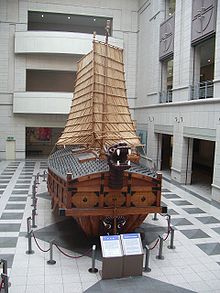Turtle ship

The turtle ship was a type of warship built in Korea. It was used by the Koreans during the Japanese invasion of Korea in the 16th century. It was used to defeat the Japanese Navy. Because it looked like a turtle, it wascalled turtle ship.
Shape[change | change source]
Outside[change | change source]
It has a dragon-shaped head, which can fire cannons through its mouth. Its tail can also fire artillery. Turtle ships have 12 cannons on each side. In total there are 24 cannons. As lots of iron nails are stuck in its back, nobody can approach it easily. Moreover, people who are in turtle ships can see the outside, while people cannot look into it.
Inside[change | change source]
Its inside is divided into two floors, one of which is the place where cannons are and the other is where people can row. There are twenty four rooms. Nineteen of them are where soldiers can take a rest. Three of them are where weapons, such as swords, arrows and spears, are. In the other three rooms, iron goods can be stored. On the bottom, there is a huge water tank, which can make float and sink.
Scale[change | change source]
At first, turtle ships were small warships which could hold about 100~150 soldiers. However, after the Japanese Invasion of Korea in 1592, it expanded from a two-storied warship to a three-storied one and the hull was longer.
Performance[change | change source]
Offensive Disposition[change | change source]
It has several cannons from front to back and side to side, including a dragon-shaped head. Therefore, it take an important role in breaking through the enemy lines at the head of fleets. In addition, it is assumed that iron nails stuck in its back might hit and sink enemy ships with the water tank full.
Defensive Disposition[change | change source]
Because it has iron nails and wooden boxes covered with swords in the back, it is distinguished in warding off attacks against enemies.
Maneuverability[change | change source]
It has ten paddles in each side, and four rowers are arranged to one paddle. As its bottom is flat-shaped, it's really easy to maneuver in large tidal ranges, such as The West Sea and The South Sea of Korean Peninsula. It's also possible to do a half-turn in the middle of moving.
References[change | change source]
- ↑ Hawley, Samuel: The Imjin War. Japan's Sixteenth-Century Invasion of Korea and Attempt to Conquer China, The Royal Asiatic Society, Korea Branch, Seoul 2005, ISBN 89-954424-2-5, p.195f.
- ↑ Turnbull, Stephen: Samurai Invasion. Japan’s Korean War 1592-98 (London, 2002), Cassell & Co ISBN 0-304-35948-3, p.244
- ↑ Roh, Young-koo: "Yi Sun-shin, an Admiral Who Became a Myth", The Review of Korean Studies, Vol. 7, No. 3 (2004), p.13
